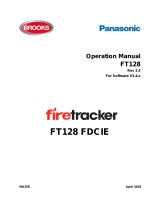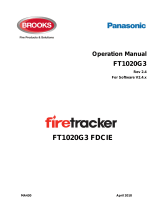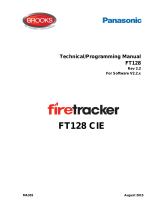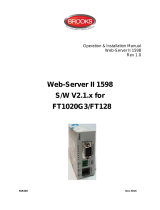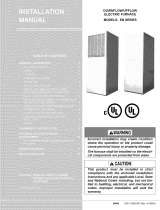Page is loading ...

Title
Technical Datasheet
Addressable I/O Module with
Isolator
4461
Page 1 of 4
Created Checked TDS No. Rev
2/12/2020
0
Original Issue
A.S.
Engineering
TDS070 0
Date
Rev
Description
2/12/2020
2/12/2020
Addressable I/O Module
with Isolator
4461
Product Description
The addressable generic I/O unit 4461 is a programmable inputs / outputs COM loop module with built-in short circuit
isolator. Connection of 4461 is via the screw terminals as shown in Figure 2 page 4. All inputs and outputs are
programmable via EBLWin.
The 4461 is fully functional when configured with FT1020G3 and FT128 for software ≥ V2.4. For software < V2.4 or to
use in FT512, 4461 can be configured as a 3361 i.e. backward compatible, refer to the systems compatibility shown
in Table 1, page 3. Red LED is provided in 4461 to illuminate when the function “Toggle LED”' is selected in EBLWin.
Note: currently, when “4461 for fan” is programmed as “3361 for fan”, the fan status input In0 will not be supervised.
The unit is intended to be surface mounted and for indoor use. The 4461 can also be mounted inside a metal enclosure
to meet specific requirements.
4461 provides two generic programmable relay outputs and three programmable inputs. Two of the inputs can be
supervised and one is non-supervised. The programmable relay can be used in many applications e.g. zone line input,
fan / damper control, MDH control, fire trips, any programmable relay contacts output, etc.
4461 Outputs
• Relay output RE0: programmed in EBLWin as any output type, either NC or NO contacts
• Relay output RE1: Programmed in EBLWin as any output type, either NC or NO contacts
4461 Inputs
1. Supervised Input Z/IN0
The supervised input Z/IN0 can be configured with the following two options:
• Zone line input (Z)
This input is intended to be used as a conventional zone line input, EOL capacitor 10 µF to be mounted in the
last unit on the circuit as shown in Figure 1 page 2. Short circuit either activate a fault or fire alarm depending
on programming in EBLWin. The state of the zone line input is dependent on the measured resistance as
shown in the following threshold levels table below:
Normal Condition
Current ≤ 1.5mA
High current fault
Current > 2mA@18V
Alarm (normal condition)
100 Ω < R < 2.0 kΩ
Alarm (if short circuit is detected as alarm)
R < 2.0 kΩ
Short circuit fault (if short circuit alarm is not selected)
R ≤ 50 Ω
Open circuit fault
R ≥ 250 Ω (approx.)

Title
Technical Datasheet
Addressable I/O Module with
Isolator
4461
Page 2 of 4
Created Checked TDS No. Rev
2/12/2020
0
Original Issue
A.S.
Engineering
TDS070 0
Date
Rev
Description
2/12/2020
2/12/2020
Note: Only 5 activated zone interfaces are allowed for each COM loop, limited by EBLWin.
• General input (IN0)
Voltage free contact input, either N/O or N/C. The state of the general input is dependent on the measured
threshold level resistance for both supervised or non-supervised options as shown in the following table:
Supervised
Not Supervised
Line resistance R (values ± 10%)
N/O
N/C
N/O
N/C
R > 43 kΩ
Fault
N/A
Activated
43 kΩ ≥ R >10 kΩ (nom. 33kΩ)
Not activated
N/A
Not activated
Activated
R ≤ 10 kΩ
Activated
N/A
Activated
Not activated
2. Isolated Input IN1
The isolated input is an opto-coupler input, activates when an external 6-30 Vdc is applied, it requires 8mA.
3. General Input IN2
Voltage free contact input, either N/O or N/C. IN2 Can be supervised if selected in EBLWin. Normally used to indicate
phase fault when 4461 is configured as “4461 for fan/damper”.
Note: The general input IN2 will not be in use when 4461 is configured as 3361.
Application Examples
Figure 1 below shows different wiring options for connecting 4461
Figure 1 Wiring options for 4461
1. Supervised input Z/IN0 used as zone line input – For connection of conventional detectors, manual call
points or fan status input when 4461 used as “4461 for fan/damper”.
a) Detector with a closing contact and an alarm resistor e.g. sprinkler flow switch input.
b) Closing contact input e.g. flow switch. It can be programmed to “Alarm at short circuit”. Short circuit
on the zone line input will then activate a fire alarm instead of a fault. End of line capacitor 10 μF.
c) Fan/damper module, has been added to EBLWin software ≥ V2.4.1. 4461 has the same
functionality as the discontinued I/O unit 3361 without general IN2 and short circuit isolator.
2. Supervised input Z/IN0 used as type general input, the input has to be programmed with a trigger
condition and to be normally open (N/O) or normally closed (N/C). EOL 33 kΩ resistor must be used if the

Title
Technical Datasheet
Addressable I/O Module with
Isolator
4461
Page 3 of 4
Created Checked TDS No. Rev
2/12/2020
0
Original Issue
A.S.
Engineering
TDS070 0
Date
Rev
Description
2/12/2020
2/12/2020
general input is configured in EBLWin as supervised. Supervision is not applicable when the input is (N/C).
3. Isolated input IN1, the input has to be programmed with a trigger condition and to be normally high (+24V)
or normally low (0V). The input is isolated and requires external 24V
DC supply.
4. General input IN2, the input has to be programmed with a trigger condition and to be normally open (N/O)
or normally closed (N/C). EOL 33 kΩ resistor must be used if the general input is configured as supervised
in EBLWin. Supervision is applicable for only (N/O).
For each output, a control expression has to be programmed and if the relay contacts selected to be Normally Open
(N/O) or Normally Closed (N/C).
Short Circuit Isolator
The 4461 has a built-in short circuit isolator that requires no separate COM loop address. Same as any other short
circuit isolator, it will be given an individual sequence number, either when programmed in EBLWin or via automatic
addressing or check loop function.
For FT1020G3 systems with software version ≤ V2.2.x, the isolators must be connected consecutively regarding
sequence number 00-64, in the COM loop's A-direction.
For FT1020G3 systems with software version ≥ V2.4.X, the sequence numbers 00-127 can automatically be generated
and sorted consecutively in the COM loop's A-direction. Function “Arrange sequence numbers” in EBLWin must be
activated. (Tools/Options/EBLWin Settings).
For more information on short circuit isolators, see the FT128 or FT1020G3 Operation or Technical Manual.
Technical Address Setting
The 4461 supports automatic addressing via EBLWin, refer to system manuals for more details.
If auto addressing is not used, the address can be set manually using the address setting tool 4414. Each COM loop
unit must have a unique COM loop address (001-253).
Notes:
1. The COM loop address and mode settings must be performed before the unit is connected to the COM loop.
2. The EOL capacitor for the supervised input must be disconnected during address and mode setting.
Addressing Mode Setting
The mode is set with the Address Setting Tool (4414) based on the following compatibility table shown below.
Table 1 Compatibility of 4461
Advanced mode NORMAL mode
FT1020G3
V ≥ 2.4.x
All versions
FT128
V = 2.4.x
All versions
FT512 Configured as 3361 in Normal mode
Not used
All versions
Isolator in use
Yes
No
Installation
Note: Terminal designated N.C. (Not Connected) is not used but it can be utilised as screen wire termination.
The 4461 can be mounted inside the FDCIE or remotely close to the external equipment. In some applications where
fire rated cables required e.g. fan control, the 4461 will be mounted in a metal enclosure. Two metal enclosures
available:
BAMFME: Field module metal enclosure, fits 2 x 4461 (330x240x70) mm
BAMFMS: Field module metal enclosure, fits 1 x 4461 (240x160x70) mm

Title
Technical Datasheet
Addressable I/O Module with
Isolator
4461
Page 4 of 4
Created Checked TDS No. Rev
2/12/2020
0
Original Issue
A.S.
Engineering
TDS070 0
Date
Rev
Description
2/12/2020
2/12/2020
Figure 2 Loop connection and PCB designator
Specifications
Note: All current consumptions are valid at the nominal voltage and at 25 °C.
Voltage:
Allowed
Normal
12-30VDC (15-30V when the monitored input is
used as zone line input)
24V DC
Current:
Quiescent (incl. Z /In0)
Active (incl. internal LED)
≤ 4.3 mA
≤ 15 mA
Monitored inputs used as zone line input:
Min voltage (at 15V COM loop voltage)
Max voltage
Max current (maximum detector current consumption)
Limitation (maximum short circuit current)
Maximum conductor resistance
Maximum conductor capacitance
DC 12V DC 30V
1.5 mA
10mA typical
50 Ω
50 nF
Isolated Input:
Max voltage, active Min
voltage, active
Max voltage, inactive
Min voltage, inactive
30VDC
6V
DC
1VDC
-30VDC
Relay outputs:
contact rating 2A@30V
DC
Address range
1-253
Address setting
Auto addressing (or with address setting tool)
Ambient Temperature:
Operating
Storage
-10 to +50⁰ C
-20 to +60⁰ C
Ambient humidity
Maximum 95, % RH (Non condensing)
Enclosure
Standard Fibox. 110H x 110W x 49D mm
Material and IP rating Polypropylene, IP 65
Approval
ISO/AS 7240.17 & ISO/AS 7240.18
FDCIE
/
